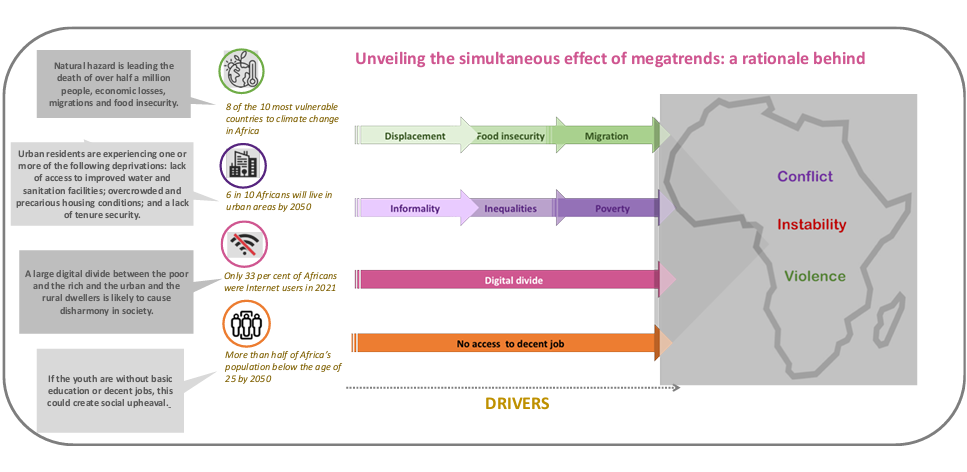Authors: Stephen Chundama, MaryAnne Iwara, Giuseppe Tesoriere, Sweta Saxena
The question of whether peace leads to development, or the other way around, is an old one. However, the Secretary-General recently remarked that, “[While] development in itself is not enough to secure peace....., development is essential. No peace is secure without inclusive and sustainable development that leaves no one behind”.
Literature on economic development has long supported the notion that macroeconomic stability, strong and inclusive institutions, and sound macroeconomic policies are essential for strong growth, which if inclusive, leads to stable social and economic conditions. In that regard, peace is a prerequisite for socioeconomic development because violent conflicts impose huge social and economic costs, as demonstrated by Cerra and Saxena (2008). In Africa, civil wars cause a permanent loss in output of about 3 percent while unconstitutional changes in governments or dictatorial regimes cause a loss of about 5 percent. When economic conditions deteriorate, social services suffer, causing poverty and inequality. Hence, it is no surprise that Goal 16 of the 2030 Agenda speaks to the promotion of peaceful and inclusive societies, providing access to justice for all, and building effective, accountable, and inclusive institutions at all levels.
To this end, building peaceful and inclusive societies requires an understanding of the determinants of conflicts and fragility that cause such events.1 In the current context, the 4 megatrends - demographic shift, urbanization, climate change and digital transformation – if not managed well, present a huge threat to peace and security at all levels – national, regional, and global. For instance:
-
Rapid urbanization increases inequality, while income disparities erodes social cohesion and increases political upheavals (World Social Report (2020).
-
In the past 50 years, climate change induced droughts in Africa caused the death of over half a million people and economic losses of more than $70 billion (Health Policy Watch 2023), creating social upheaval, food insecurity and massive migration. Globally, more than 50 million people in fragile and conflict-affected countries are expected to fall into hunger by 2060, while conflict-related deaths would increase by 8.5% to 14% in countries facing extreme temperature increase.
-
With one million unemployed African youths entering the labour market monthly and more than 50 percent of Africa’s population below the age of 25 by 2050, the inability to provide decent jobs threatens peace and development.
-
As digitization increases, the expansion of artificial intelligence and misuse of social media by spreading disinformation and misinformation heightens anxiety and 1 Growth Dynamics: The Myth of Economic Recovery - American Economic Association (aeaweb.org) animosities among civilians and decreases trust in authorities (SIPRI, 2021). This increases fragility and can lead to disruptions in the social, cultural, or political order of society.
Our data for 18 African countries representing 58 percent of the population from 2000-2020 further bears witness to these links. We find that each megatrend has a statistically and positive association with conflict. More importantly, we witnessed a significant and simultaneous increase in the correlation between conflict and the megatrends recently. For instance, the correlation coefficient between megatrends (collectively) and conflict is three time higher in the last five years (2016-2020) than those recorded over the entire period that was sampled (2000-2020).
Hence, mainstreaming the megatrends in policymaking is imperative for establishing and maintaining peace and security.
The figure highlights the complexity and interconnectedness of issues relating to development and peace and requires systems thinking to advance the achievements of the SDGs. Therefore, it is essential to connect and leverage non-peace and security tools to achieve the SDGs.
Three important policy actions for consideration
1. Prioritize policies that focus on specific drivers and root causes of conflicts, violence and disasters. This includes improved sustainable and resilient urban planning, agricultural technology solutions, climate-focused agricultural policies, vocational training and upskilled interventions combined with welldefined industrial policies focussed on rural development, and social protection, among others.
2. Target long- and short-term interventions by estimating the length of time required for interventions to yield results, as well as fostering an integrated approach to collectively resolving the four megatrends.
3. Strengthen institutional collaborations for robust knowledge generation and sharing. This includes building capacities to collect timely data, exploring relationships between variables, forecasting the costs and benefits of interventions and analysing the impact of megatrend related policies across time.



